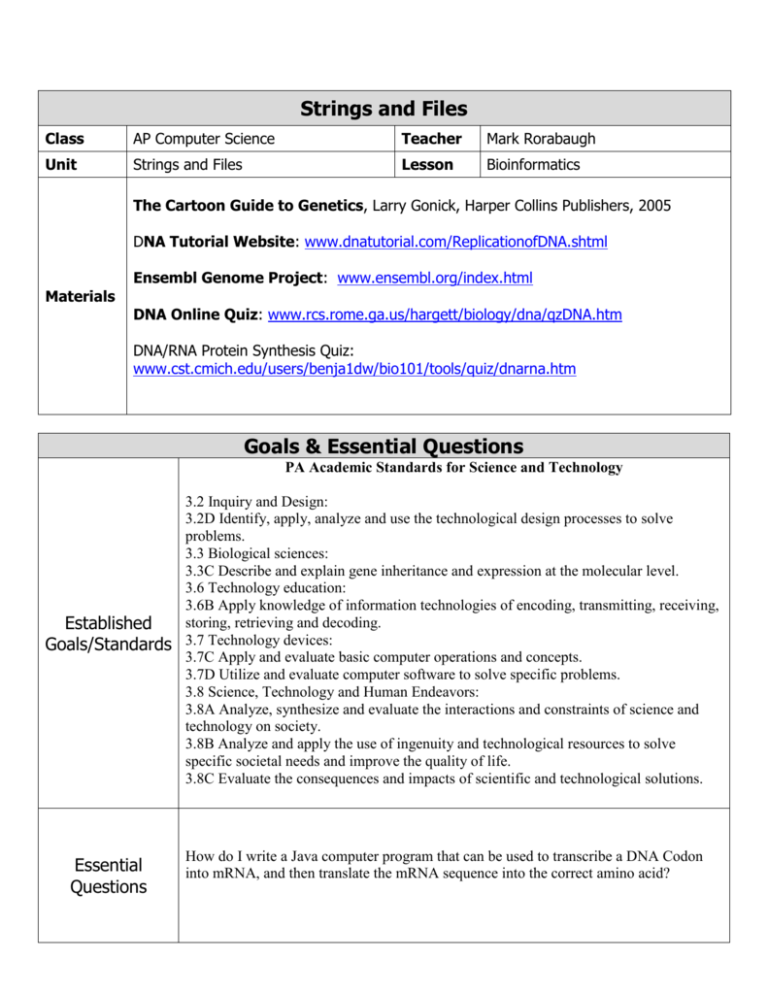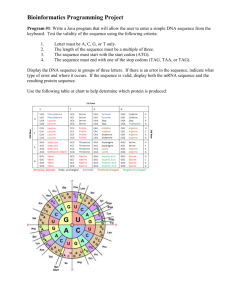Lesson Plan - Bioinformatics Activity Bank
advertisement

Strings and Files Class AP Computer Science Teacher Mark Rorabaugh Unit Strings and Files Lesson Bioinformatics The Cartoon Guide to Genetics, Larry Gonick, Harper Collins Publishers, 2005 DNA Tutorial Website: www.dnatutorial.com/ReplicationofDNA.shtml Ensembl Genome Project: www.ensembl.org/index.html Materials DNA Online Quiz: www.rcs.rome.ga.us/hargett/biology/dna/qzDNA.htm DNA/RNA Protein Synthesis Quiz: www.cst.cmich.edu/users/benja1dw/bio101/tools/quiz/dnarna.htm Goals & Essential Questions PA Academic Standards for Science and Technology 3.2 Inquiry and Design: 3.2D Identify, apply, analyze and use the technological design processes to solve problems. 3.3 Biological sciences: 3.3C Describe and explain gene inheritance and expression at the molecular level. 3.6 Technology education: 3.6B Apply knowledge of information technologies of encoding, transmitting, receiving, storing, retrieving and decoding. Established Goals/Standards 3.7 Technology devices: 3.7C Apply and evaluate basic computer operations and concepts. 3.7D Utilize and evaluate computer software to solve specific problems. 3.8 Science, Technology and Human Endeavors: 3.8A Analyze, synthesize and evaluate the interactions and constraints of science and technology on society. 3.8B Analyze and apply the use of ingenuity and technological resources to solve specific societal needs and improve the quality of life. 3.8C Evaluate the consequences and impacts of scientific and technological solutions. Essential Questions How do I write a Java computer program that can be used to transcribe a DNA Codon into mRNA, and then translate the mRNA sequence into the correct amino acid? Know BIOLOGY Codon DNA DNA Sequencing Genetic Code Genome mRNA Mutation Nucleotide Protein Synthesis Ribosome RNA Start Code Stop Code Termination Sequence Transcription Translation SNP COMPUTER SCIENCE String Class File Streams Loops Arrays ArrayLists Decision Structures Graphical Use Interface (GUI) Environment Methods Classes Objects Understand Reading a DNA Sequence Transcribing a DNA sequence into mRNA sequence Translating a mRNA sequence into a protein sequence Recognizing a Start Code and Stop Code in the mRNA Sequence Reading of a Codon Chart or Table Recognizing invalid or unreadable mRNA sequences. The FASTA Format for representing nucleotide sequences in the Ensembl database. Recognizing effects of a mutation in the DNA sequence. Do Translate a small sample DNA Sequence into a Protein Sequence by hand. Write a Java program to translate a sample DNA Sequence from the keyboard into a Protein sequence for display. Write a Java program to translate a sample DNA Sequence from a text file into a Protein sequence for either display or to a text file. Download a DNA sequence for a given chromosome from the Enbembl Genome Project Website. Write a Java program to find the effects of a SNP in the genetic code. Locate the staring positions of a given DNA sequence supplied by the user. Planned Learning Activities & Assessments Day 1: Review the basic terminology and basic concepts of The Genetic Code. Using the basic resources provided, study the process of transcribing a DNA sequence to mRNA, then translating mRNA sequence to a protein sequence. Students will have access to the materials described above. Formative Assessment: DNA Online Quiz. Assignment: More research on DNA Basics Day 2: Formative Assessment: DNA / RNA/ Protein Quiz. Use this quiz to determine the readiness of the class for this project. Give the students some simple DNA sequences to translate into a protein sequence. Students will learn the major tests for validating the code: 1. 2. 3. 4. Letters must be A, C, G, or T only. The length of the code must be a multiple of three. The coding must begin with a start codon (ATG). The code must end with a stop codon (TAG, TAA, or TAG). Teacher will observe the students as they work on these problems. Programming Project #1: Given a Program Template, complete the code that will allow the user to enter a simple DNA sequence from the keyboard. Test the sequence for validity. If there is an error, indicate the reason for the error. If the sequence is valid, display the mRNA code, and the resulting protein sequence. Day 3: Review the concept of opening, reading, and closing text files. Programing Project #2: Given a Program Template, complete the code that will allow the user to select a text file that contains a DNA sequence. Test the sequence for validity. If the sequence is valid, display the mRNA code, and the resulting protein sequence. This program will use the basic structure of Programming Project #1. Output must be in a form that allows the user to easily compare the DNA, mRNA, and Protein sequences. Day 4: Review the concept of mutations (SNP) in the DNA sequence and the effect of producing proteins based on this mutation. Programming Project #3: Given a DNA sequence from a text file, randomly cause a mutation at a single location in the DNA sequence. Compare this to the original sequence to determine whether or not there is a change in the protein. Identify the mutation a silent, missense, or nonsense. Day 5: Programming Project #4: Have the use enter a specific DNA sequence, then find the starting location for all occurrences on this sequence for this given gene or indicate that it does not exist.








